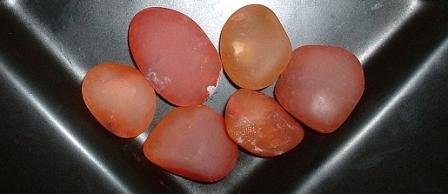This (step 2) assumes that you have completed step 1 and have a batch of completely scrubbed clean rocks ready to load up for smoothing before polishing.

It is IMPORTANT that as you read this page – bear in mind that you do this page TWICE – once with 220 grit and once with 400 grit.
The reason we say “scrubbed clean” rocks is because as noted in step 1 – there must be absolutely zero grit left stuck in the rocks or on them from the previous roll. It is fairly easy to spot on lighter samples, but not so easy to see on darker types of gemstones. A quick tip would be to place them in a wash barrel – a barrel which you keep aside for the sole purpose of washing bits of unwanted grit from stones, and let them run in water and plastic pellets for a couple of hours to shake the grit out of them.
At this step – you have a choice to make really. Our preference is to have a different barrel for each grit size. This way you will never be trying to gently smooth off ground stones using 220 or 400 grits in a barrel which has been used with 80 grit. It can be very difficult to completely clean out all the grit from a used barrel. The grit particles can be literally hammered into the sides of the barrels and the crevices of the lid threads and moldings if there are any. Obviously this incurs a cost, so as long as you scrub the barrel clean of any leftover grit (use a toothbrush and/or a larger but coarse brush) to do the job, you should be ok. However with multiple tumbles, a given barrel will become an “80 only” barrel over time as in most cases they just won’t become clear enough of old grit leftovers.
Whatever you decide, scrub the rocks themselves as clean as possible and place the cleaned rocks into the barrel then pour in water as in step 1. Fill the barrel again to a point which almost covers them and then add some 220 grit or 400 grit depending on whether or not you have already done the 220.
Use around one heaped tablespoon of 220 or 400 (depending where you are upto) grit per one pound of rock. Tumble the barrel for around 5 to 7 days using 220 and then repeat this page using 400 grade grit.
Looking at the specimens after each completed 220 or 400 stage will reveal virtually no difference in the rocks to the naked eye – so don’t worry – everything is going fine! However at an almost microscopic level, changes have occured on the surface of the stones and you can try to imagine what these would look like if magnified.
After 80 – the surface is scoured with thousands of scratches which dig into the rock to a depth of however large a piece of 80 grit is. After 220, these scratches aren’t as deep, they are only as deep as however large a piece of 220 grit is. After 400, they are less deep again, as deep as however large a piece of 400 grit is.
Because grit particles get smaller with each increase in value of the grade number, the scratches are smaller. Also, the grit breaks up during the process, so the final scratches are actually less deep than the size of the grit particles of a given grade.
Very basically – this is how it works. Once we have rocks which are completely scoured with tiny tiny scratches, so small that the rock is smooth, we can move onto the final polishing stage – which is step 3.
